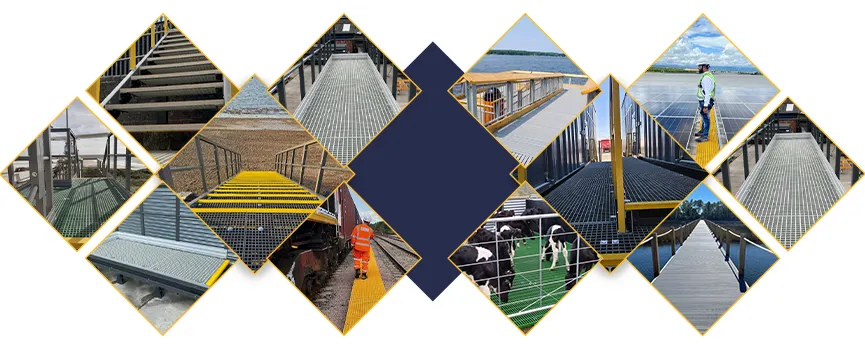loading...
- No. 9, Xingyuan South Street, Dongwaihuan Road, Zaoqiang County, Hengshui, Hebei, China
- admin@zjcomposites.com
- +86 15097380338
- Welcome to visit our website!
glass reinforced plastic structure
The Structure and Benefits of Glass Reinforced Plastic (GRP)
Glass Reinforced Plastic (GRP), also known as Fiber Reinforced Plastic (FRP), is a composite material made from a polymer matrix reinforced with glass fibers. This combination of materials allows GRP to exhibit remarkable physical and mechanical properties, making it suitable for various applications across numerous industries. The structure of GRP, coupled with its advantages, has led to its rising popularity in engineering and manufacturing fields.
Structure of GRP
The core structure of GRP consists of two primary components the polymer matrix and the glass fibers. The polymer matrix, usually made from thermosetting resins like unsaturated polyester, epoxy, or vinyl ester, serves as a binding agent that holds the glass fibers together while providing the material with shape and surface finish. This resin is crucial because it defines the material's chemical resistance, temperature tolerance, and overall durability.
The glass fibers are the reinforcement component of GRP, providing significant strength and stiffness to the composite. These fibers are typically produced through a process known as pultrusion, which creates long strands that can be woven into various fabric structures like mat, cloth, or roving. The orientation and density of these fibers can be adjusted during manufacturing to tailor the mechanical properties of the final product. For instance, aligning the fibers in a particular direction can yield greater strength in that direction, which is advantageous in applications requiring specific load-bearing capabilities.
Manufacturing Process
The manufacturing processes for GRP vary, but they generally include techniques such as hand lay-up, spray-up, pultrusion, and resin infusion. In hand lay-up, layers of glass fibers are manually laid into a mold and then saturated with resin. This process is labor-intensive but provides the flexibility to create complex shapes and is often used in custom applications.
The spray-up process combines resin and chopped glass fibers into a spray gun, allowing for a quicker application to large molds. Pultrusion continuously pulls fibers through resin and into a heated mold, creating consistent cross-sectional shapes, which is ideal for producing long components like beams or rods.
glass reinforced plastic structure

Resin infusion uses a vacuum to pull resin into a closed mold containing the glass fibers, resulting in a stronger product with a superior surface finish. Each of these processes has its own set of advantages and is chosen based on the specific application and desired characteristics.
Benefits of GRP
The advantages of using GRP are numerous, making it a material of choice for various applications. One of the most significant benefits is its high strength-to-weight ratio. GRP is much lighter than metals, yet it can offer comparable or even superior strength. This characteristic makes it particularly suitable for sectors like aerospace, automotive, and construction, where weight reduction is crucial for efficiency and performance.
Another key benefit is GRP’s corrosion resistance. Unlike metals, GRP does not rust, making it ideal for environments subjected to humidity, chemicals, or seawater. This property extends the lifespan of components and reduces maintenance costs, which is especially advantageous in coastal infrastructure, marine applications, and chemical processing plants.
Additionally, GRP has excellent thermal and electrical insulation properties, making it suitable for applications where temperature fluctuations or electrical isolation are concerns. In the energy sector, for example, GRP is used in wind turbines and electrical housings to ensure safety and efficiency.
Furthermore, GRP can be molded into complex shapes, offering design versatility that is difficult to achieve with traditional materials. This flexibility enables designers to create more efficient and ergonomic components and structures.
Conclusion
In conclusion, Glass Reinforced Plastic (GRP) is a highly versatile composite material that combines a polymer matrix with glass fibers to produce a robust yet lightweight structure. Its unique properties, including corrosion resistance, excellent strength-to-weight ratio, and design flexibility, make it increasingly popular across diverse industries. As manufacturing technologies continue to advance, the potential applications and advantages of GRP are likely to expand, playing a vital role in the future of materials science and engineering.
-
The Rise of FRP Profiles: Strong, Lightweight, and Built to LastNewsJul.14,2025
-
SMC Panel Tanks: A Modern Water Storage Solution for All EnvironmentsNewsJul.14,2025
-
GRP Grating: A Modern Solution for Safe and Durable Access SystemsNewsJul.14,2025
-
Galvanized Steel Water Tanks: Durable, Reliable, and Ready for UseNewsJul.14,2025
-
FRP Mini Mesh Grating: The Safer, Smarter Flooring SolutionNewsJul.14,2025
-
Exploring FRP Vessels: Durable Solutions for Modern Fluid HandlingNewsJul.14,2025
-
GRP Structures: The Future of Lightweight, High-Performance EngineeringNewsJun.20,2025
